The process of fertilizing Coconut trees should start from the time of planting. This will ensure better and faster development in the early stages of life. With proper care, a Coconut palm tree bears 50 to 200 fruits every year for 80 years, so learning how to fertilize Coconut trees is crucial for the longevity of the tree.
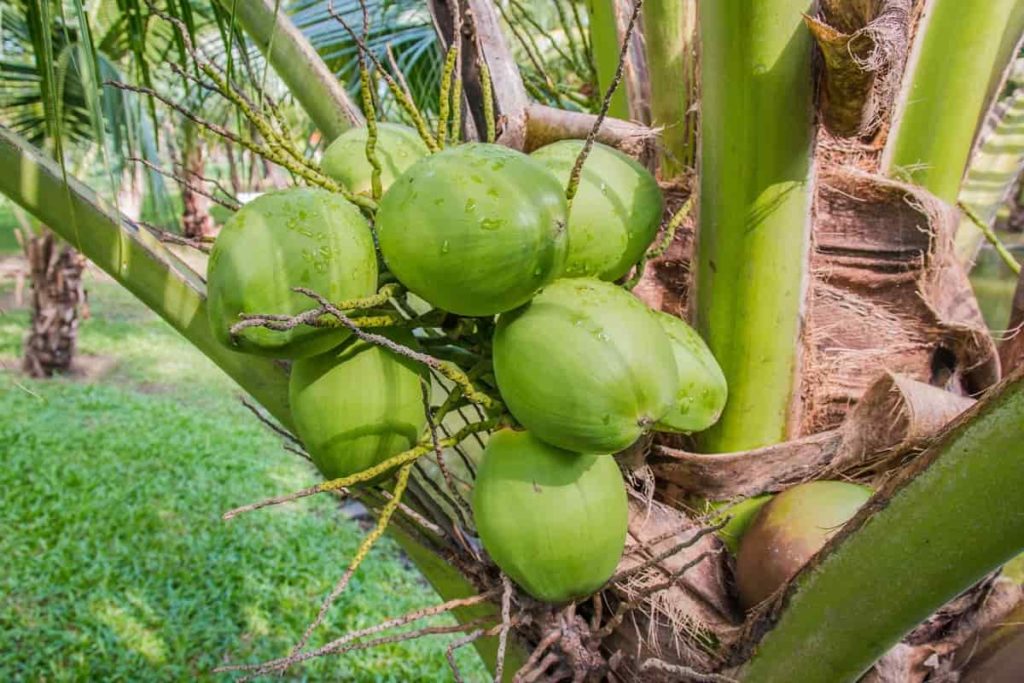
Fertilizer is the most important and expensive input to increase crop yields. There is no doubt that fertilizer plays a very active role in increasing crop yields. Let’s check out the best fertilizer for Coconut trees.
Essential elements in Coconut nutrition
Among the basic nutrients, potash (K) is the most important in Coconut cultivation, followed by nitrogen (N). There is a general reaction to the application of K and N; whereas the reaction of phosphorus (P) is observed only in certain limited and local conditions. In secondary nutrients, magnesium (Mg) and chlorine (Cl) have beneficial effects, followed by calcium (Ca), sulfur (S), and sodium (Na). In micronutrients, zinc (Zn), boron (B), and manganese (Mn) are required under some limited conditions.
Nutrient effects in Coconut trees
Nitrogen – The supply of nitrogen, which is a component of chlorophyll as well as plant cells, is important for the rapid growth and development of plants. Nitrogen promotes the growth of plant parts, especially the leaves and twigs, as well as the number of leaves.
Phosphorus – Phosphorus is found mainly in leaves and seeds and is also found in parts of plants where cells are strongly dividing. It plays an important role in root growth and productivity.
Potassium – Potassium, in addition to these, has important and specific functions, which it performs jointly with phosphorus. Since potash is especially important for the formation of sugar, fat, and fibrous material, high demand for potash in Coconut palm can be expected.
In case you miss this: Coconut Gardening for Beginners, How to Start
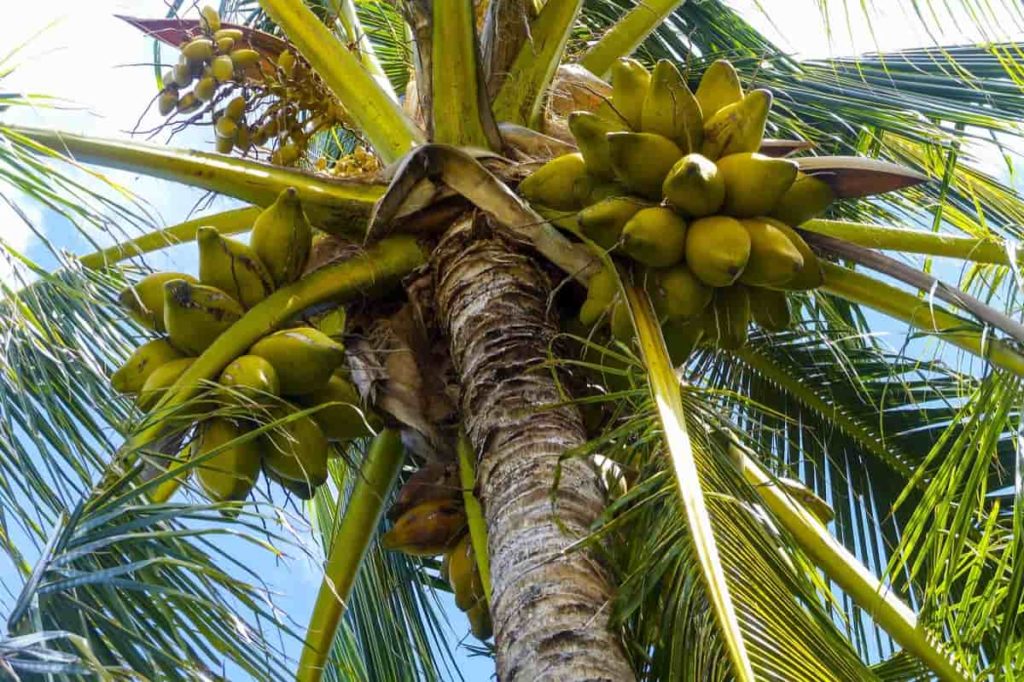
Manganese – It helps in the formation of chlorophyll in the leaves. It is present mostly in the lower leaves and provides favorable conditions for growth in the small stages of the palm.
Magnesium – Magnesium (Mg) has beneficial effects on the general growth and productivity of the palm. It also plays an important role in photosynthesis and leaf greening.
Sulfur – Sulfur increases oil content and lowers N and sugar content.
Best NPK fertilizer for Coconut trees
Coconut trees need to be fertilized, which has the highest potassium, followed by nitrogen, phosphorus, and chlorine, but care must be taken to balance the fertilizer. 1000: 500: 2000 gm NPK / palm/year is recommended for hybrid Coconut in coastal areas.
- Firstly, apply enough basic fertilizer and use urea as basic fertilizer. Fertilizer has a strong effect and can accelerate the physical growth of plants. Then we use only organic fertilizer.
- In the early stages, we should properly increase the use of inorganic chemical fertilizers with high nitrogen content to promote the germination and differentiation of Coconut trees and improve flowering rate.
- During the flowering period of the Coconut trees, we use more phosphate fertilizer to increase the flowering rate, prevent the flowers and fruits from falling, and improve the production and quality of the Coconut.
- During the full growth of the Coconut, in the later period, we use potassium fertilizer to promote the propagation of the Coconut and to improve the taste and thickness of the fruit.
Regular fertilizer from the first year of planting is essential for good plant growth, early flowering, and bearing, and high yield of Coconut palms. The commonly recommended dose of fertilizer for Coconut palm is as follows;
| Age | N (gram) | P205 (gram) | K2O (gram) |
| 1st year | 50 | 40 | 120 |
| 2nd year | 160 | 120 | 400 |
| 3rd year | 330 | 240 | 800 |
| 4th year | 500 | 320 | 1200 |
In case you miss this: High Density Coconut Plantation – Spacing, Yield
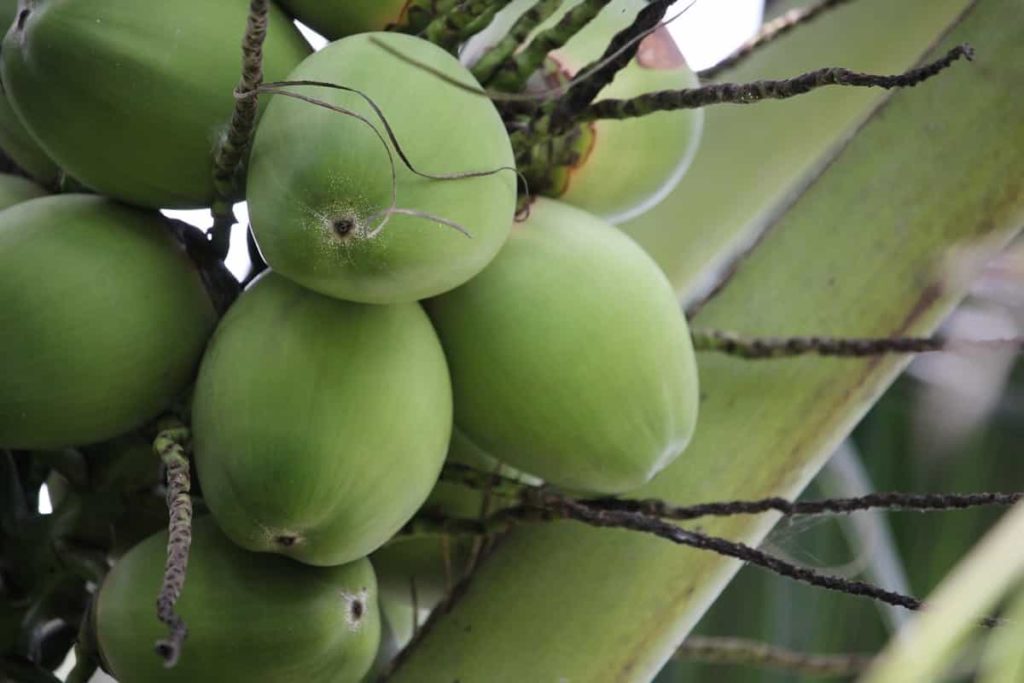
Method of application of fertilizer
The first method – Open a circular basin of a 1.8 m radius with a depth of 20-25 cm at the end of the basin and apply the recommended amount of fertilizer with compost and green leaves. The second method – Dig a circular trench 30 cm wide and 20-25 cm depth. Apply the recommended fertilizers along with compost & a lot of green leaves and cover the basin with topsoil.
Biofertilizer recommendation
- 50 g of Azospirillum
- 100 g Azophos or 50 g of Phosphobacteria
- 50 g of VAM
All the above contents are mixed in a sufficient quantity of FYM or compost and then apply near feeding roots once in 6 months/palm starting from planting. Though, do not mix with chemical fertilizers and pesticides.
Different stages for fertilizing Coconut trees
The fertilization of Coconut trees varies depending on the specific stage of their development.
Coconut fertilizer in transplant
The large green leaves of the Coconut palm require extra nitrogen. Granular fertilizer with a ratio of 2-1-1 should be used which includes both slow releasing and fast releasing nitrogen. The immediate release will provide the nitrogen acceleration to accelerate the growth of the palm while slow release will gradually provide nitrogen to the developing roots. At the time of transplant, there are specific palm fertilizers that can be used or a combination can be applied.
In case you miss this: Growing Dwarf Coconut Trees – A Complete Guide
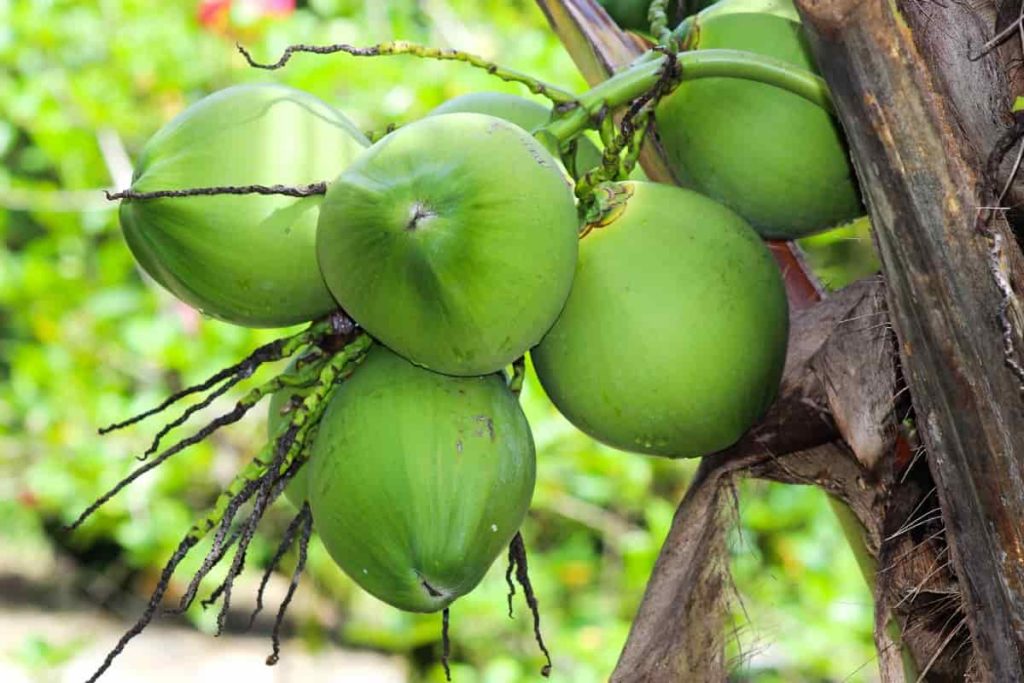
Fertilizing young Coconut palm trees
Once the transplant is established, fertilizing Coconut palms is of constant importance. Foliar fertilizer is the best application method. They are sold with either macro-elements or microelements. Macro-elements include:
- Nitrogen
- Potassium
- Phosphorus
Micro-elements include
- Manganese
- Molybdenum
- Boron
- Iron
- Zinc
- Copper
They usually come together but may need a wetting agent to help the fertilizer pass through the waxy coating of the palm trees where it can be absorbed. If the fertilizer does not contain a wetting agent, add three to five drops of liquid detergent to each gallon (4 L.) of the mix.
Foliar fertilizer for young Coconut trees should be applied when the weather is dry for 24 hours. Apply at intervals of one to three months each – monthly is better. After the first year, foliar fertilizer can be discontinued. Granular applications are plentiful and should still be used in a 2-1-1 ratio but can now be done every three to four months.
Organic fertilizers
Green manure farm organic wastes like cattle, carabao, pigs, goats, chickens, compost can be used to replace the commercial fertilizer requirements. Residues of Coconut crown as organic fertilizer and nitrogen-fixing legumes as N-source while cocopeat and husk for chlorine.
In case you miss this: Organic Coconut Farming, Cultivation, And Production
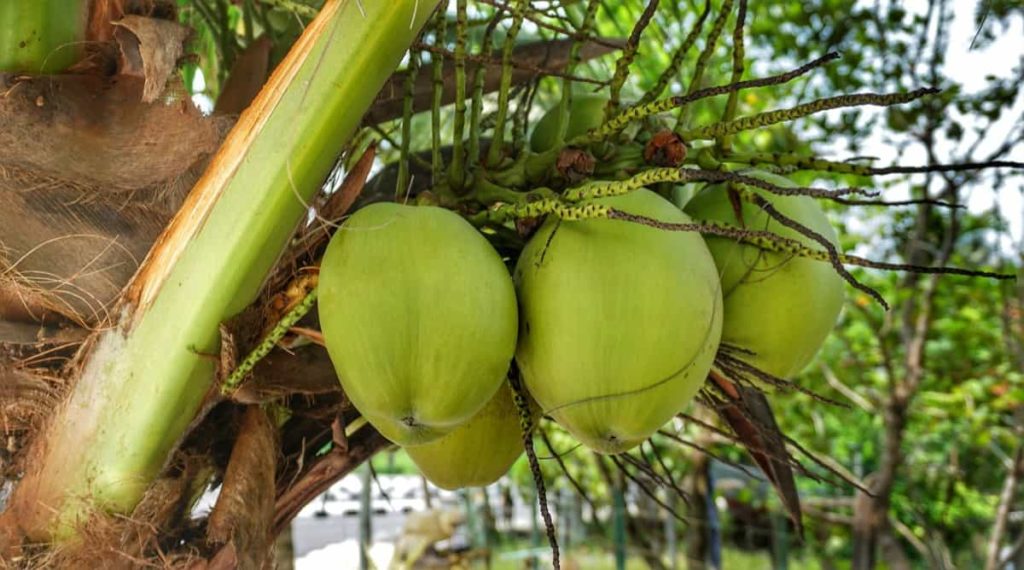
How to apply
Fertilizer can be applied in two ways.
1. In flat areas, it can be spread in the ring weeded area around the palm base (radius of about 1.0 to 1.5 meters) and then through the fork to add fertilizer to the soil.
2. In hilly areas, hole placement is recommended and fertilizers are placed 5 cm deep around the base of the palms in 8 to 10 equidistant holes and then covered with soil.
Organic recycling – Green manure crops such as sunnhemp, wild indigo, calapagonium, or daincha can be sown and plowed at the flowering time as an alternative to compost. Sow sunnhemp in the basin @ 50 gm/date palm and incorporate before flowering. Coir pith compost / vermicompost can be made from coir pith / Coconut leaves / other wastes from the Coconut grove can be applied.
Compost manuring
- Apply 50 kg FYM or manure or green manure from the 5th year onwards. Apply 1.3 kg urea (560 g N), 2.0 kg superphosphate (320 g P2O5), and 2.0 kg muriate of potash (1200 g K2O) in two equal distributions during June-July and December-January.
- Apply fertilizer in a 1.8-meter circular basin from the base of the palm, add them and irrigate.
- During the second, third, and fourth year, ¼, ½, and ¾ doses of the above fertilizer schedule should be adopted.
- There should be enough moisture during the time of manuring.
- The above fertilizers can be fertilized at monthly intervals with 75% of the recommended dose.
- Phosphorus can be added to the basin as superphosphate and can be added by drip when good quality water is available.
Vermicomposting
The local species of Eudrilus has been identified from the Coconut orchard, which is superior to other species in composting waste from Coconut plantations. This earthworm can be rapidly grown in a 1: 1 mixture of cow dung and decomposed organic waste. Put 10 kg of this mixture in a bucket and release 50 to 100 worms. In 1 to 2 months 150 to 300 grams of earthworm will be produced.
When to fertilize a Coconut tree
The timing of fertilization of Coconut trees also varies, especially due to climatic conditions and soil type. Although there are usually hundreds of possibilities, can divide ourselves into two major groups;
In case you miss this: Coconut Seed Germination, Time Period, Process

- When the crop is managed in dry conditions, on sandy or coarse-textured soils, in the rainy season nitrogen is divided into three parts.
- In clay soils that can retain more nutrients can be applied twice a year, once at the beginning and once at the end of the rainy season. When it comes to indoor crops, fertilization takes place in spring and summer. In the autumn-winter, with cold days and low temperatures, the Coconut tree will not grow, so it is better not to fertilize.
Fertilizer schedule and method
Fertilizer application time is when there is sufficient moisture in the soil. In rainfed conditions, apply fertilizers in two split doses, 1/3 during the initial rains of southwest monsoon in April-June and 2/3 in September-October. In irrigation conditions, apply three or four equal amounts of fertilizer in April-May, August-September, December, and February-March.
Apply lime or dolomite during April-May, magnesium sulfate during August-September, and organic matter during June-July. An adult palm requires 1 kg of dolomite or 1 kg of lime + 0.5 kg of MgSO4 per year. Apply fertilizers and manures in circular basins at 2.0 m in diameter and 10 cm deep from the base of the palm, which is opened after the onset of the southwest monsoon. For mature Coconut plantations, it is recommended to use MgSO4 at the rate of 500 g / palm/year.
Boron deficiency can lead to characteristic malformation of leaves such as hook leaves, nut cracking, dried female flowers, etc. Borax @ 50 gm/tree twice a month at monthly intervals after the first symptom appears cures the deficiency. In areas affected by root rot disease, borax @ 300 grams per seed and borax @ 500 grams per adult tree are recommended. The use of Magnesium @ 500 gm MgO per palm is beneficial for the management of root (wilt) diseased palms to restore the strength of the palm and maintain the yield.
Frequently asked questions about Coconut fertilizers (FAQ)
Do Coconut trees need fertilizer?
Coconut trees needed some essential fertilizers. These palms are at risk of nitrogen deficiency, which is characterized by the yellowing of the oldest leaves throughout the canopy.
What nutrients do Coconut trees need?
Coconut palms require macronutrients nitrogen, potassium, and potash, and micronutrients, such as magnesium and boron, to grow thick, green leaves and long, straight trunks.
Why are my Coconut leaves turning yellow?
Nitrogen deficiency is usually caused by insufficient nitrogen in the soil. Nitrogen deficiency begins as the oldest leaves have a uniform light green color/yellowing (uniform chlorosis). As the deficiency increases, younger leaves will also become discolored.
- Types of Pesticides Used in Agriculture: A Beginner’s Guide
- Economical Aquaculture: A Guide to Low-Budget Fish Farming
- 15 Common Planting Errors That Can Doom Your Fruit Trees
- How to Make Houseplants Bushy: Effective Tips and Ideas
- Innovative Strategies for Boosting Coconut Pollination and Yield
- Pollination Strategies for Maximum Pumpkin Yield
- The Complete Guide to Chicken Fattening: Strategies for Maximum Growth
- Natural Solutions for Tulip Problems: 100% Effective Remedies for Leaf and Bulb-Related Issues
- Revolutionizing Citrus Preservation: Towards a Healthier, Greener Future
- Natural Solutions for Peony Leaf and Flower Problems: 100% Effective Remedies
- Maximizing Profits with Avocado Contract Farming in India: A Comprehensive Guide
- Natural Solutions for Hydrangea Problems: 100% Effective Remedies for Leaf and Flowers
- The Ultimate Guide to Choosing the Perfect Foliage Friend: Bringing Life Indoors
- From Sunlight to Sustainability: 15 Ways to Use Solar Technology in Agriculture
- The Ultimate Guide to Dong Tao Chicken: Exploring from History to Raising
- The Eco-Friendly Makeover: How to Convert Your Unused Swimming Pool into a Fish Pond
- Mastering the Art of Delaware Chicken Farming: Essentials for Healthy Backyard Flocks
- 20 Best Homemade Fertilizers for Money Plant: DIY Recipes and Application Methods
- How to Craft a Comprehensive Free-Range Chicken Farming Business Plan
- Brighten Your Flock: Raising Easter Egger Chickens for Beauty and Bounty
- How to Optimize Your Poultry Egg Farm Business Plan with These Strategies
- Subsidy for Spirulina Cultivation: How Indian Government Schemes Encouraging Spirulina Farmers
- Ultimate Guide to Raising Dominique Chickens: Breeding, Feeding, Egg-Production, and Care
- Mastering the Art of Raising Jersey Giant Chickens: Care, Feeding, and More
- Ultimate Guide to Raising Legbar Chickens: Breeding, Farming Practices, Diet, Egg-Production
- How to Raise Welsummer Chickens: A Comprehensive Guide for Beginners
- How to Protect Indoor Plants in Winter: A Comprehensive Guide
- Ultimate Guide to Grow Bag Gardening: Tips, Tricks, and Planting Ideas for Urban Gardeners
- Guide to Lotus Cultivation: How to Propagate, Plant, Grow, Care, Cost, and Profit
- Agriculture Drone Subsidy Scheme: Government Kisan Subsidy, License, and How to Apply Online
- Ultimate Guide to Raising Araucana Chickens: Breed Profile, Farming Economics, Diet, and Care
- Bringing Hydroponics to Classroom: Importance, Benefits of Learning for School Students
- Ultimate Guide to Raising Polish Chickens: Breed Profile, Farming Economics, Diet, and Care
- Ultimate Guide to Raising Australorp Chickens: Profile, Farming Economics, Egg Production, Diet, and Care
- Silkie Chicken Farming: Raising Practices, Varieties, Egg Production, Diet, and Care
- Sussex Chicken Farming: Raising Practices, Varieties, Egg Production, Diet and Care
Good information
Hi, instead of applying normal salt, what are other fertilizers best for coconut trees with yellow leaves? Ammonium nitrate or ammonium sulphate? Thanks
Thanks a lot for the detail about how to cultivate coconut tree. Iam having 350 coconut trees about 27 years old in my nearly 8 acres of land. Also about 120 palm oil trees in T. Narsipura Taluk, Mysore District. Really, it helped a lot for the coconut farmers like me. Once again thank you sir so much for your comment.
Very good article–Would like to know if there is a company that provides a fertilizer specifically for coconut trees. I have looked on the Web and come up empty handed with a brand or a manufacturer of the same. Would appreciate if anyone knows of a company. Thanks—Paul
Thank you soo much its valuable information I am having 150 coconut trees in my 2acers land. but getting only 1500 coconut its not sufficient amount. your information will support to increase the amount.
Informative article on how to apply fertilizer on coconut trees. Would like to learn new skills on coconut farming as well as value addition
We have just planted coconut plant, so what fertilizer will we put in it and after how many days?